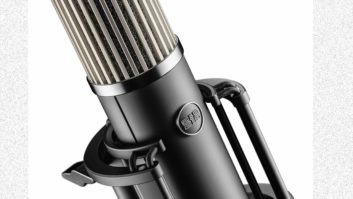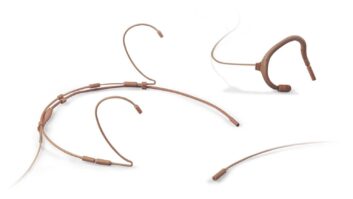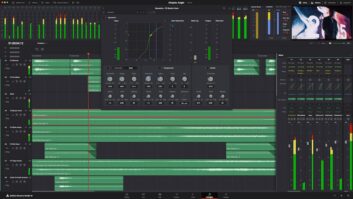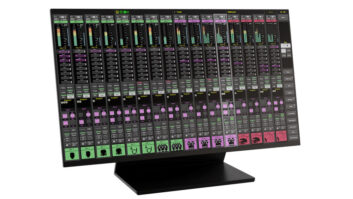By Dan Wolfson.

Indicative of how the annual AES conventions lay the ground work for tomorrow’s technology today, paper presentations at the 1984 convention based on inventor and theorist David Schwartz introduced his patented approach to digital audio data compression. 25 years later, amidst a digital entertainment environment built on that foundation (see “A Peek Into MP3’s Past“), Schwartz is preparing to introduce another radical technology concept at this year’s Convention.
Schwartz tells the story of how he conjured up the idea for his Laser-Accurate technology. “I was having dinner with my wife, Mary, in a restaurant,” he recalls. “On the table was an oil lamp from which a thin ribbon of smoke was rising. I noticed that every time Mary spoke, the column of smoke would move in response. That’s when the light bulb went on in my head: The column of smoke was a way to ‘see’ the sound very accurately. If I could read that smoke with a laser and a very sensitive photo-receptor, it could be the most accurate microphone ever.”
That was in December, 2004. Schwartz wrote up his idea that same night and applied for a patent early in 2005 that was allowed in June of this year. He plans to license the technology through his company Schwartz Engineering & Design (SED).
Sound Waves
Schwartz’s idea is to put as little as possible between the sound source and its conversion to an electrical impulse. That means doing away with the mechanical aspect of microphones; specifically, the diaphragm and the back plates (on condenser microphones). Their physicality is their shortcoming, he asserts. When a sound pressure wave hits the assembly, it takes a finite amount of time for the assembly to react. Then, after displacement by the sound wave, the diaphragm springs back, driving a reverse wave of its own, interfering with next incoming pressure wave. These two effects are responsible for distortion and noise, he maintains.
There’s been research into using optical solutions to replace diaphragms before, notably at Bell Labs and Brookhaven National Labs, which have experimented with using lasers and photo-detectors to measure sound waves in air directly, based on pressure differentials. (The Soviets were caught in 1987 using the windows of the Pentagon as microphone diaphragms, bouncing infra-red lasers off of the window surfaces from their hilltop embassy in Washington, D.C. and reading the modulation in the reflected beam as audio.) Though a number of U.S. patents have been issued along these lines, no commercial pro audio products based solely on laser detection have made it to market. The difficulty of directly “seeing” the changes in air caused by sound pressure has rendered previous laser-based designs impractical.
The Fix
Schwartz’s wrinkle to the equation is to make the air stream visible to the laser-detector system by the addition of very small particles (1 to 3 microns) like those that make up smoke or water vapor. In some ways, the moving stream of smoke and air is analogous to a moving magnetic tape; sound pressure disturbs the flow of smoke similarly to the way a fluctuating magnetic field disturbs the orientation of magnetic particles. A laser beam passing through the smoke is modulated by the variations in smoke density, which corresponds to peaks and troughs in the sound pressure waves. The electrical output of the photo detector is a direct representation of the modulation of the smoke stream. Because the smoke-air stream has negligible mass compared with any diaphragm and is not constrained by mounting points, it is both sensitive and non-interfering. Potentially, distortion and noise could be reduced by an order of magnitude compared with conventional designs.
The mechanics of light-based sound transduction are equally exotic. The aperture that lets sound in is placed at a 90-degree angle to the laser-photoreceptor axis. The gas is introduced into the chamber by a nozzle at the bottom, propelling it along the longitudinal axis of the housing, escaping through a hole at the other end of the chamber, remaining in the unit’s housing and returning to a base pump unit that also houses the electronics. Maintaining a consistent flow rate of air is critical, presenting a smooth (i.e., low-noise) surface on which the laser can “write.” If the flow rate of the medium is not fast enough, internal reflections and new incoming waves could affect accuracy. The complete system requires a DSP circuit and software to control parameters including laser power, photocell gain and beam diameter.
Schwartz acknowledges that his smoke and laser microphone technology is still in the developmental stage; they are still isolating and controlling the many variables that affect performance of the system, including smoke flow dynamics, sound input aperture configuration, laser power, photo detector speed and detector sensitivity. Receptor sensitivity, which he expects to reach 120 dB, is currently at around 40 dB. And he fully expects to encounter some skepticism from gearheads who regard the word “distortion” as a term of endearment.
On the other hand, the fundamentals of mechanical microphone technology have been relatively unchanged for over a century. Digital audio technology has given sound the equivalent of the “perfect black” that high-definition has given video: absolute silence. A microphone to match that might be a desirable thing.







